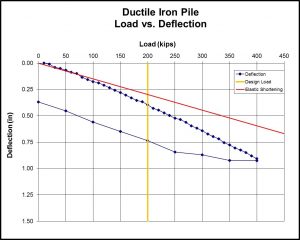Ductile Iron Piles Support 8-Story Hotel in Connecticut
Introduction:
A new 8-story hotel is part of the extensive redevelopment efforts occurring in the neighborhood of the new Downtown North Hartford Baseball Stadium in Connecticut. The 53,400 square foot Candlewood Suites hotel is a steel-framed structure with column loads ranging from 400 to 800 kips. Isolated locations of tension resistance were required at foundations supporting the braced-frame structure. Initial tension loads were estimated as 5 tons per pile, but increased to 9 tons in final design.
Project Challenges:
The project team was faced with providing a cost-effective deep foundation support solution (supporting both compression and tension loads) on a site with soil conditions consisting of up to 8 feet of variable, debris fill. The fill was underlain by soft to stiff silt and sandy silt to depths of 22 feet followed by a medium dense to dense sand layer. Shale bedrock was encountered in the borings at depths of 25 to 32 feet below grade. Groundwater was about 15 feet below grade.
Geotechnical Design/Build Solution:
The project was initially designed using 100 ton steel H-piles (HP 12×74 or HP 14×73) for foundation support. Helical Drilling proposed a value engineered alternative to replace the specified H-piles using Ductile Iron Piles. The low vibration, driven Ductile Iron Piles solution was designed to achieve a 100 ton allowable capacity to provide a 1:1 replacement. The Ductile Iron Pile VE was selected to save foundation costs and schedule.
The 100 ton capacity was achieved using a Series 170/9.0 (170 mm diameter with 9 mm wall thickness) Ductile Iron Pile filled with 4,000 psi neat cement grout and using a high-strength #9 reinforcing bar installed in the center. The piles providing tension resistance were initially designed based on the frictional resistance between the pile material and the soils. However, the increase in tension demand up to 36 kips (ultimate) in final design was easily addressed by using an oversized 270 mm conical grouting cap installed on the 170/9.0 piles. During installation, sand cement grout was pumped to fill the annular space created by the oversized cap and develop a friction bond zone in the sand and silt layers. This small change allowed the DIP solution to move forward with little impact to the construction approach and achieve much greater tension resistance.
To verify the working capacity of 100 tons, a full-scale compression load testing was performed to 200% of the design load (400 kips). Results showed about 0.4 inches of movement at the 100% design load (200 kips) and about 0.9 inches at the 200% design load (400 kips). Net (permanent) deflection after unloading the pile resulted in less than 0.4 inches. The pile was then tested to more than 500 kips to evaluate the response at higher loads. Tension reactions for the test consisted of 8 friction DIPs to match the tension resistance approach. The reaction piles were instrumented during loading and results confirmed the tension capacity and response.
The total project size totaled 124 piles with 32 of the piles installed as friction piles developing tension resistance with the oversized conical grout shoe. All piles were driven through the silt and sand to bear on the rock. Termination of the piles occurred when a “set” criteria of less than 1 inch of penetration in 50 seconds was achieved. Pile installation by Helical Drilling occurred in 12 working days on the site.

Ductile Iron Pile Advantages:
- High capacity (100 ton) compression resistance to replace H-piles
- Rapid installation
- Easy adjustment to increased uplift demand

